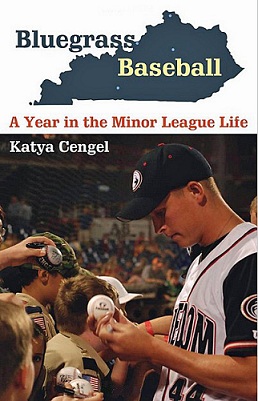On January 29 I wrote a blog article that chronicled the inadequate pay structure of minor league players. That structure, which has changed very little over the past 35 years, puts in place some of the trials of being a minor league player. In that article the nature of fast food diets was touched upon due to inadequate meal allowances. Very few minor league players would know how to cook as an answer to poor eating habits. Even if they did there is not much time or motivation for that with a full work day usually extending over the evening meal time. In addition to that they play one half of their games away from home and have to rely upon their meager meal allowance for that nourishment.
In addition to relying on fast food, minor league pay makes it very difficult for players to have adequate living conditions. They often rent facilities together and at the lower levels billeting is not uncommon. Katya Cengel spent a full year following four minor league teams. In her book, Bluegrass Baseball, she most likely has provided the greatest insight into the living conditions of minor league players. As an example she witnessed nine Latin players living in the cramped conditions of a two bedroom townhouse. She noted that air mattresses were common in place of beds and sheets served as curtains. With extremely active schedules, players must often report to the field not nearly as rested as they should be. To compound their problems, Cengel writes that many do not have cars and even getting to the ball park can be a challenge.

Katya Cengel’s book Bluegrass Baseball details life in the minor leagues.
(Photo courtesy of katyacengel.com)
Minor league players face other challenges in their quests for success as baseball players. They travel from town to town, by bus, especially at the levels below AAA. The rides are often long, again cutting into sleep time. Upon arrival, they check into the cheapest motels and eat the cheapest meals.
Once they are drafted, minor league players are totally at the will of the drafting team. They are assigned to a level, which may or not be the best level, depending on spots available. During the season many are moved from level to level. While often this move is a promotion, it may be just to fill a spot at a higher level that has to be filled. A demotion is likely if the players struggles at the next level or even at their present level. The uncertainty of knowing where they fit and the lack of communication regarding the moves places added pressure on young baseball players. Duke von Schamann pitched at three levels in the Dodger system in 2012 after being drafted in the 15th round – Ogden, Great Lakes and Chattanooga. His time with the Lookouts provided only a small sample of five good innings. He will most likely start with the Rancho Cucamonga Quakes in 2013 because there is no room for him in the starting rotation in Chattanooga. It becomes almost impossible for minor league players to have a family life as they may not know where they will be playing from one week to the next or playing at all.
In addition to moving from level to level minor league players may be released by the parent club at any time. In the fall of 2012 the Dodgers released twelve minor league players, six of whom were drafted in 2010 and two others in 2011. Players that are released then hope to catch on with another team and the whole process starts over again or their career is simply over. Kelvin De La Cruz, formerly Pitcher of the Year in the Cleveland organization, and once on the 40 man roster was released by the Detroit Tigers last November. The Dodgers then signed the 24-year old lefty starter to a minor league deal. This might turn out to be a good signing.

Left-handed pitching prospect Kelvin De La Cruz was recently acquired by the Dodgers after being released by the Tigers. De La Cruz has spent 7 seasons in the minor leagues.
(Photo credit – Jon SooHoo)
To fill needs with the parent club minor league players are often moved from position to position. This may be to their benefit if they can fill that need but adds additional pressure as they are moved out of a comfort position while trying to compete for a spot at the next level. Players drafted for a position often expect to play that position for their career simply because they feel they were good enough to be drafted because of that position. At times the move works out, such as it did for Kenley Jansen converting from catching to pitching. More often than not it ends with less than successful results.
Minor league players are confronted by yet another challenge of which most of us would not be aware or at least have not given it much thought. That challenge is switching from using an aluminum bat to a wooden bat. Players find that switch takes serious adjustment. Wooden bats are heavier so bat speed is decreased. That may cause players to adjust and make adjustments in their stance and swing, the same stance and swing that got them drafted in the first place. The only other option is to bulk up and that is risky business. Switching to a wooden bat will most often be reflected in a decrease in power numbers. Because the aluminum bat is lighter in the high school and college ranks, hitters are more able to get around on inside pitches and pitchers are less willing to pitch hard inside as aluminum bats don’t break. When they arrive in the minor leagues hitters must learn to deal more efficiently with inside pitches and and pitchers have to begin more efficient use of the inside of the plate.
Through it all career ending injuries are always just over the horizon as they were for Dan Opperman (1987), Kiki Jones (1989), Ron Walden (1990), and David Yocum (1995), all pitchers and all Dodger first round draft selections. Yet, confronted by a situation almost designed to cause failure, minor league players persevere and keep their dreams alive as long as possible.




 March 2nd, 2013 at 5:40 am
March 2nd, 2013 at 5:40 am  by Harold Uhlman
by Harold Uhlman  Posted in
Posted in 

You bring up some interesting perspectives, Harold. Thank you for the insight into the life of a Minor League ballplayer. They do have it tough, don’t they… and wouldn’t we all have loved to experienced that in our youth?
Another great article.
I heard at a Quakes game one night that many of the Quakes players live with host families and those families can be seen around the stadium looking for donations and 50/50 money etc.. for a players fund. Sounds like my home, the player plays and I go to work and pay for it all. Somethings wrong with this deal I just have to figure it out !!